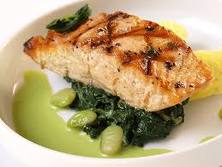After a recent trip to the supermarket, I wondered if spending double for my wild salmon was a worthwhile investment. I remember reading a few articles many years ago when salmon hit the Top 10 List dissuading folks from purchasing farm raised salmon for a multitude of reasons, but surely we have addressed these issues by now…or have we?
The American Heart Association recommends eating fish, specifically fatty fish like salmon, to help prevent heart disease. Wild salmon are a great source of omega-3 fatty acids and have received recent attention for their role in the decreased risk of heart disease and for their anti-inflammatory properties. These roaming fish have a varied diet, but feed mostly on toxin free krill that give salmon the distinctive red coloring. However, with the increased popularity of salmon, wild stocks were becoming depleted and farm raised salmon seemed the most logical answer. Almost immediately, fisheries were assaulted with complaints regarding the use of antibiotics, color pellets and unnatural feeds. Surely, something would be done.
Now, years later, on our grocers shelves lay a wide variety of salmon. While looking for the best cut, I spied a deep red, thick fillet that looked gorgeous. I could almost taste the flavor on site alone. This was clearly the choice piece. Over in the corner lay a paltry slab of thinner, and literally, pale by comparison, fish. However, my gorgeous piece of fish was sadly farm-raised, dressed up to outshine the natural beauty of the wild salmon. Additionally, this pig dressed as a princess was half the price. How do I in good faith advise people to spend more money on the less desirable fish?
Well, the less desirable fish is really not so less desirable. To obtain the so-called beauty of a salmon, the poor farm-raised salmon are indeed fed food pellets that contain genetically modified foods, antibiotics, color and other unnatural substances typically unavailable to a wild salmon in order to keep them disease free, encourage growth and maximize the brilliant salmon color. Farmed fish are naturally grey in color and lower in omega-3's as they are unable to roam free. Far more dangerous than the magic pellet is another substance found in high concentration in farm-raised salmon. Polychlorinated biphenyls (PCBs) are mixtures of up to 209 individual chlorinated compounds with no known natural source. PCBs have been used as coolants and lubricants in transformers, capacitors, and other electrical equipment because they resist burning and serve as excellent insulators. The manufacture of PCBs was stopped in the U.S. in 1977 because of evidence PCBs build up in the environment and cause harmful health effects. However, PCBs persist in the environment and find their way through run off into many tributary rivers and oceans. Fish absorb PCBs from contaminated sediments and from their food pellets. The compound is then stored in fat tissue. Fatty fish have higher concentrations of PCBs. Farm raised salmon are generally bigger in size and contain more fat than wild salmon. PCBs are stored in fat and remain there for an extended period of time; therefore farm raised salmon contain more PCBs.
Some interesting facts to promote the purchase of wild salmon…
Over 60% of the fish eaten in the United States is farm-raised.
Farmed Salmon:
• have seven times the levels of PCB's as wild salmon
• have 30 times the number of sea lice
• are fed chemicals to give them color
• are fed pellets of chicken feces, corn meal, soy, genetically modified canola oil and other fish containing concentrations of toxins
• are administered antibiotics at higher levels than any other livestock
• have less omega 3's due to lack of wild diet
• are crowded into small areas inhibiting movement, and causing disease
• EWG Report: In July 2003, the Environmental Working Group EWG released a report stating that farm raised salmon purchased in the United States contain the highest level of PCBs in the food supply system. In the report, EWG reported that farm raised salmon have 16 times PCBs found in wild salmon, 4 times the levels in beef, and 3.4 times the levels in other seafood. EWG recommends that consumers choose wild salmon instead of farm raised salmon, and they should eat an 8 oz serving of farm raised salmon no more than once a month.
• Science Journal: In January 2004, the journal Science warned that farm raised salmon contain 10 times more toxins (PCBs, dioxin, etc.) than wild salmon. The study recommends that farm raised salmon should be eaten once a month, perhaps every two months as they pose cancer risks to the human beings.
As athletes on a mission to obtain essential fatty acids, particularly omega-3s, we must also pay close attention to how our EFA's are delivered. Has anything been done to manipulate nutrients in our food? Tweaks to the food supply can sometimes inadvertently do more harm than good. Invest in natural and organic foods, read your labels and continue to stay well informed…and don't buy the dressed up pig!















Comments